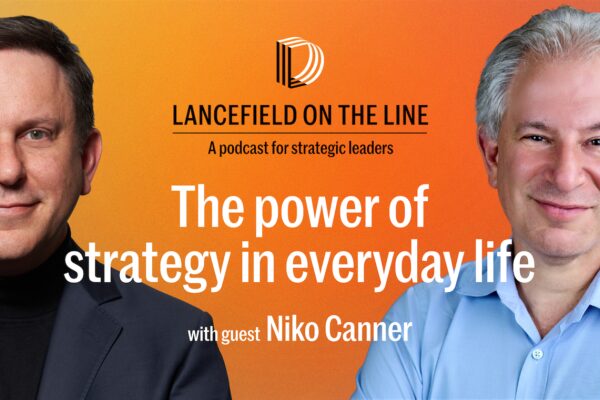
Growing up in the far reaches of northern New England, where the snow often began falling in the late fall and would continue falling through late spring, I often heard of the Inuit’s rich vocabulary to describe snow - with distinctions for snow that is falling and the snow already on the ground, for the slushy ice you find near the sea and the freshwater ice that you melt to make drinking water.
The staggering nuance that words can capture, and also their occasional, striking paucity, makes me think of some of the conversations I have been having lately about strategy. What people mean when they say the word “strategy” can be as multi-dimensional as “snow,” but with only one, relatively flat word to transmit what is in their mind’s eye. Say the word “strategy” to a dozen people and - in my experience - nearly a dozen different conversations will subsequently unfold. Sometimes a leader says “strategy” to mean “I want a blueprint that we can use to steer by over the coming handful of years.” Sometimes a leader says “strategy” to mean “Conditions are changing - both outside and inside our organization - and I want a dynamic view of our path ahead that can help us spot when a window of opportunity is opening which we would seize.”
Lately, I have been thinking about a different application of strategy -- which my colleagues and I have been calling “strategy in the world.”
When we think of “strategy,” we often mean a variation of what we’ll call classic strategy: a team combines introspection and analysis with a body of experience to formulate a view of the road ahead. Classic strategy takes its form from the facts at-hand, the knowledge “in the room,” and the analysis that might help us better see into the future. It’s premised on the belief that close examination of the facts of the situation, and focused deliberation about our options, will yield the insights needed to make the critical decisions we confront.
Emergent strategy, on the other hand, takes as its starting point that analysis and deliberation, on their own, cannot yield the insights needed for the strategic situation. Emergent strategy is designed around the conviction that intentional engagement with partners, collaborators and other stakeholders, beyond the walls of any one organization, can fuel powerful learning and innovation - adding up to meaningful strategic advances over an arc of time. FSG’s John Kramer and Mark Kania have written extensively on collective impact, and how that exemplifies an emergent strategic approach. It’s not hard to see the value of that approach - while acknowledging that it contemplates a kind of reflection and refinement that is only possible over a long arc of time.
Both forms of strategy - classic and emergent - are powerful; both have their place. Lately, though, my team and I have found ourselves in conversations with leaders who are contemplating a consequential strategic pivot. They can see the outlines of that pivot, but an outline is a good distance from “a multi-year strategy,” and they don’t experience themselves as having the extended runway that emergent strategy so often contemplates.
These leaders face a situation suited for "strategy in the world." When we talk about “strategy in the world,” we mean a body of clearly formulated, time-bound work that is being used by a leadership team to (1) actively test ideas and hypotheses in the world; (2) gain ground, insight and resources via that experimentation; (3) observe how both external and internal conditions unfold; and (4) make decisions about how to move forward
This approach makes sense when an organization’s leaders recognize that studying the question of "what should we do?", on its own, won't yield the insights needed to set a strategic direction. Instead, leaders face a situation in which they need a feedback loop of acting in the world; a moment is at hand to “learn by doing” before tying themselves, and their organization, to the mast of a multi-year strategic plan. Perhaps the organization is entering an interstitial period - with a strategy that must do more than optimize what the organization already knows how to do, but which can’t yet reach upwards towards a reimagined future in a single step.
We have been working - for instance - with a leadership team taking stock of the degree to which the pandemic drove significant programmatic reinvention. The success of this reinvention has caused them to reconsider both long- and strongly-held tenets about their path to impact. With a decade of experience honing their model, eighteen months of reinvention during an unprecedented moment like the pandemic feels like a relatively thin experience base from which to chart an entirely new future course. Further testing and learning -- tightly scoped to unfold over a clear time period -- could help them to both interrogate and evolve their durable commitments. In this case, “strategy in the world” represents a way to shape a path that could take the organization from their initial chapter (with one programmatic footprint) to a next strategic era, designed to combine the best of their earlier work with what they’d learned from their pandemic pivot to produce impact at a new level of scale.
In another instance, we are working with a leadership team of an organization that has produced cutting-edge insight generation about some of the world’s most important challenges. Relatively new in a landscape dense with actors, they are valued and trusted by their funders and are seen as having a powerfully distinctive voice in the field in which they work. It is not hard to imagine that many similarly situated teams would approach strategy by asking how to make their insight generation work more efficient or stickier. But in this case, we found leaders wrestling with more profound and existential questions, grappling with how to build on the strength of their insight generation capabilities to play a more direct role in change-making. “Strategy in the world,” in this case, is a way of experimenting with how to intentionally develop and reconfigure their organization’s capabilities and the deployment of those capabilities without assuming that they can - in one leap - reinvent themselves. Said differently, strategy in the world is a way of beginning to experiment with retooling, while avoiding the risk of pursuing a strategy that is compelling, but which is - today - too far beyond their organization's current capabilities, resources and networks to successfully execute.
To be sure, this approach - strategy in the world - is not the right match for all strategic endeavors, and we are not suggesting it be used everywhere and always. There are many instances where we readily coach leaders to adopt classic strategy, or to weave in emergent learning. On the other hand, strategy in the world might make sense when leaders:
- Have an ingoing hypothesis about the need to meaningfully evolve their strategic direction. That hypothesis doesn’t exist as a fully-formed picture, and it can’t simply be pressure-tested via a program of introspection, study, or analysis
- Observe that their operating conditions are fluid, and that their unfolding will make a significant difference for the path chosen
- See that choosing a path forward requires some “testing,” and they can clearly isolate what most needs to be learned
- Are ready to commit to a tightly crafted learning agenda that can help them take some “short, fast steps” that give them meaningful clues about the road ahead
- Believe that experimentation can help them iterate, revise and refine the expression of their strategic commitments, before they do the work of fleshing out a multi-year strategic plan
I am curious to hear from you about the kinds of strategic undertakings that this calls to mind. Where have you found yourself confronting a fundamental question that isn’t a good match for the tools we so often deploy in strategy, or grappling with the kind of problem that capable leadership teams - even when they’ve called in experienced advisors - can’t simply “think their way out of”? Are there particular forms of strategic reflection that you believe “strategy in the world” could well be a good match for addressing?
Having one word for the light snow that falls softly and a different word for the heavy snow that falls in a blizzard might strike our ears as poetry, but one linguist described the profound efficiency of these words, saying “whether ice is fit to walk on or whether you will sink through it…[is] a matter of life or death.” Something similar could, of course, be written of strategy. Choosing the wrong approach - an approach that, on the one hand, simply consolidates what a leadership team already safely knows, or on the other hand, stretches an organization too far beyond what it can credibly commit to - can attenuate organizational resilience and undermine leaders’ credibility. Choosing wisely and with intention from among a palette of approaches to strategy is among the most critical choices that leaders will make.



